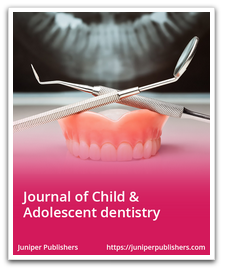Child & Adolescent Dentistry - Juniper Publishers
Opinion
Dental implants have changed the overall face of dentistry since a decade. For majority of the adult population who suffers from tooth loss, dental implants have given excellent relief in terms of function, esthetics and psychological benefits.
A large number of children suffer tooth loss at a wide range of ages. Frequent causes of tooth loss in children are congenital hypodontia, trauma and caries. The absence of teeth leads to loss of function and lack of normal alveolar growth, along with unpleasant esthetics that hamper the psychosocial development of the young child. Conventionally, tooth loss in children has been managed with conservative approaches which includes space maintainers, removable dentures and sometimes fixed prosthesis. However, these treatment approaches have a lot of disadvantages such as esthetically inappropriate, repeated loosening of the prosthesis and the constant need for replacing the prosthesis due the arch shape /space discrepancies.
Researchers have been constantly working for a permanent or long-lasting solution for children suffering from tooth loss. This led to the thought that dental implants could be an option in growing children for transitional replacement which led to the clinical usage of narrow diameter non-Osseo integrating dental implants. Transitional implants are narrow diameter implants that were developed to support provisional fixed restorations during the phase of osseointegration of the definitive implants and are usually placed simultaneously with definitive implants [1].
Today many authors report successful placement of implants in children, however the long-term results on the stability, effect on alveolar bone growth and face etc. remains controversial. Any surgical insult to the tissues in a growing phase can have a significant impact on the growth and development. In early childhood, increase in the width of the cranial base and the growth of the median suture influences the transverse growth of the maxilla. At puberty, the sutural growth is accelerated which if the first osntha lla thre dimensions to be completed in a child during adolescence [2]. Even though there have been no problems reported in pediatric implants in the anterior maxillary region, an early implant placement in growing children can lead to diastema formation with the adjacent teeth as transverse growth occurs [3,4].
Implant surgery is invasive and painful for a pediatric patient. An average dental implant penetrates the bone to not less than 10 millimeters. As the diameter decreases, the length of the implant may be increased so as to compensate for the implant-bone interface area which is proportional to the stability of dental implants. Bone growth ceases at approximately 18 to 21 years of age in both males and females, which means the bone undergoes rapid growth and remodeling in growing children than adults.
A metal implant placed within the alveolar bone is reported to restrict the growth of the bone immediately surrounding the implant surface, whereas the rest of the bone grows normally which creates a ditch in the area of the alveolar bone where implant is placed. Furthermore, due to the growth of the tissues surrounding the implant at a faster pace than the rest of the bone, the implant gradually tends to look submerged which makes it difficult to place a prosthesis (temporary or permanent) above it.
A multidisciplinary approach including the involvement of an orthodontist, pedodontist and a periodontist or an implantologist skilled in soft and hard tissue management around implants with a comprehensive treatment plan may be able to successfully place dental implants with a satisfactory long term outcome in children suffering from congenital anodontia or multiple tooth loss. However, implants might not be a reliable option for provisional single tooth replacement in growing children.
To Know more about Child & Adolescent Dentistry
Click here: https://juniperpublishers.com/index.php





No comments:
Post a Comment